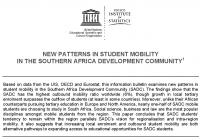The demand for higher education continues to grow as universities compete globally to attract students. But are students opting for private or public institutions? To what extent do they pursue their education abroad? Are women moving into fields traditionally dominated by men, such as science and computing? These are just some of the questions faced by policymakers looking to expand and diversify their national tertiary education systems.
Based on its annual data collection, the UIS produces a range of indicators to track trends in tertiary education at the global, regional and national levels. These data include: enrolment and graduation ratios disaggregated by sex and type of programme; enrolment rates in private and public institutions; and graduates by field of study.
The UIS has also developed a series of unique indicators to track the flows of foreign or mobile students. These data reveal the shifting demand for higher education, especially in developing countries, by showing where students go to study and where they come from.

